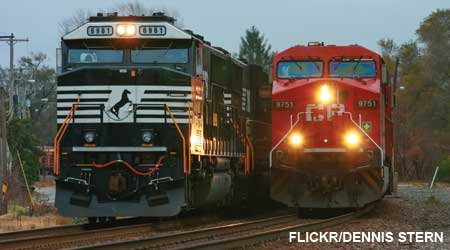Stay updated on news, articles and information for the rail industry
October 2009
Rail News: Rail Industry
Bountiful U.S. corn crop, plentiful Canadian wheat harvest keep railroads optimistic about grain traffic
Since last year's disappointing fall harvest, grain's been a pain for U.S. railroads. Through 2009's first 37 weeks, the volume of corn, soybean, wheat and other agricultural products moving along their networks has dropped about 22 percent compared with volume from the same 2008 period.
In Canada, last year's near-record grain crop has helped railroads at least keep traffic in the black so far in 2009, albeit by only a less-than-1-percent margin. Mexican railroads are the only ones in North America to register a significant boost in '09 grain traffic, which is up more than 16 percent year over year primarily because of strong demand for corn — the nation's food staple — although a severe drought is expected to impact the next crop.
The good news for both U.S. and Canadian railroads is that grain volumes are expected to soar for the former and, at the very least, remain stable for the latter.
Among the primary reasons for a U.S. grain surge:
- the U.S. Department of Agriculture is projecting a corn harvest around 13 billion bushels — which would be the second-largest crop in the nation's history — and a 100 million-bushel jump in corn exports, while domestic ethanol production is expected to increase significantly and DDG exports to China are forecasted to rise 18-fold vs. 2008;
- South American regions that produce soybeans, predominantly in Argentina, experienced a severe drought earlier this year, and Asian consumers are improving their diets by increasing fat and oil intake, presenting a golden opportunity for soybean exports into next year; and
- wheat volumes are expected to be about equal to or slightly better than last year despite sluggish domestic demand, high prices in worldwide markets and the nation's role as a residual global supplier.
A bountiful corn harvest is encouraging to CSX Transportation, which primarily moves grain to feed and processing markets, and also transports corn to eastern ethanol plants.
"The corn projection just gets better every week," says CSXT Director of Marketing-Agriculture Tim McNulty. "And about 20 to 25 percent of the corn crop will go to ethanol, so that will be a big factor with prices perhaps being cheaper."
In Canada, the next grain crop is projected to be about 8 percent to 10 percent below last year's volume. But the harvest "still will be above the five-year average," says Canadian Pacific Assistant Vice President-Grain Mike Adams.
Export wheat volumes are expected to remain strong and the domestic market is forecasted to remain stable for wheat, barley and canola.
The outlook for U.S. and Canadian railroads' capacity to efficiently handle escalating grain volumes is equally rosy, primarily because roads continue to increase train size, operate more distributed-power trains and lengthen sidings. In addition, railroads' sometimes stormy relationship with grain shippers — which dates back several decades and can be traced to rate, service and captive-shipper disputes — is becoming more workable as both parties try harder to understand and fulfill each others' needs.
Gathering storm clouds?
But it isn't all blue skies on the grain front. The U.S. wheat market could be softer than expected and take six months or longer to strengthen because consumers aren't eating as many products containing the grain and no new wheat sources are on tap. Plus, some shippers and shipper groups — such as Idaho farmers and the Canadian Wheat Board (CWB) — still are wrangling with railroads over what they perceive as high rates or costly supply-chain changes.
Last month, CWB officials claimed CN's decision to close 13 of its farmer grain-loading sites in Canada this fall might raise farmers' costs and benefit grain handlers because some farmers will have to deliver wheat to elevators owned by companies that charge handling fees. However, most of the loading facilities haven't been used for at least one year and the Class I will reduce maintenance costs by closing the sites, CN officials say.
In addition, the Soy Transportation Coalition (STC) — which comprises seven state soybean boards, the American Soybean Association and United Soybean Board — last month released a report that stated 42 percent of soybean rail moves are transported at rates the Surface Transportation Board would classify as "potentially excessive." The high rates resulted in a potential overcharge of $120 million in 2007, according to the coalition.
"There needs to be a way for railroads and the soybean industry to achieve a better balance so that one is not profiting at the expense of the other," said STC Executive Director Mike Steenhoek in a prepared statement.
Nonetheless, optimism rules among many railroads and some shippers about both the U.S. and Canadian grain markets' potential. Members of both parties also are upbeat about some of the steps they've already taken — and plan to take — to become better business partners.
Conciliate and counsel
One of those forward steps is the formation of the Ag Rail Business Council, which mostly addresses grain issues in Montana, but also tackles concerns nationwide.
Created nearly two years ago by BNSF Railway Co., the council includes representatives from the National Association of Wheat Growers (NAWG), Montana Grain Growers Association and other wheat, soybean and corn groups, as well grain merchandisers and railroad officials.
The council, which meets twice annually, held a meeting in Seattle last month during which members discussed the best ways to handle service problems in a timely manner, shipping trends, the regulatory environment and rail-car placements. Rates, as usual, also were a hot topic.
"Elevators long have passed higher rates onto farmers and not explained the increase," says Lochiel Edwards, the council's chairman and a Montana wheat farmer for more than 40 years. "Through the council, we have a realization of how freight is priced by BNSF."
Despite the recession, railroads mostly have maintained their rates and some farmers even are receiving lower rates, he says.
"It's all about promoting markets and pricing so the grain moves, and they're the ones that move it," says Edwards. "We also talk about who the customers are and when they will be buying."
The NAWG needs railroads to be successful so they can, in turn, invest in their infrastructure and provide better service, says David Cleavinger, NAWG's immediate past president, a council member and diversified grain (corn, wheat, etc.) producer in Wildorado, Texas.
"The history on both sides is to throw rocks at each other," he says. "We've done that for 30 years and what good has it done us? We both realize we need to have civil discussions and want partnerships."
The council is all about two-way communication, says BNSF Group Vice President-Agricultural Products Kevin Kaufman, who helped form the council.
"We have reduced misunderstandings substantially," he says.
Misconceptions aside
Such as a rate increase and shippers' knowledge of that hike. BNSF disputes the tone of an Agweek article published last month regarding a rate increase that took effect for Montana and North Dakota grain shippers on Aug. 1 and another hike set to take effect in January. The article correctly mentioned that BNSF handles about 95 percent of the rail service provided to Montana grain shippers, making most of them captive to the Class I. But the article painted an incorrect "our way or the highway" approach to the rate hikes and characterized the increases as news to shippers, says Kaufman.
"We announced the rate increases a month ago and all of our customers knew it was going to happen, " he says. "We haven't raised rates in three years and only some of the rates are up. Eastbound rates actually are down."
To continue to keep the lines of communication open with shippers, BNSF recently formed the North Dakota Ag Rail Business Council with the North Dakota Grain Growers Association.
The Class I also employs three ombudsmen to serve as go-betweens in the Dakotas; Montana and Washington; and Colorado, Kansas, Missouri, Oklahoma and Texas.
"They try to resolve issues quickly," says Kaufman. "It can be big issues, but many times it's the little things, like a car that didn't get delivered completely to a facility and they can see it on the track, or an empty car that's blocking someone's siding."
The NAWG recently sent a letter to Union Pacific Railroad to encourage the Class I to form an ag rail council similar to BNSF's, says Cleavinger, adding that a council helps address ongoing issues, like bottlenecks and short-line paper barriers, as well as rates.
"Idaho shippers are upset about their rates, and they're mostly captive to UP," says Cleavinger.
UP plans to get together with the NAWG and shippers to discuss their concerns, says UP VP and General Manager-Agricultural Products Paul Hammes, who declined to further discuss NAWG's letter.
The Class I long has met with shippers on an individual basis before harvests to address issues and continues to have "more regular interaction" with three shipper groups: the National Grain and Feed Association, Transportation, Elevator and Grain Merchants Association, and National Oilseed Processors Association, says Hammes.
"We participate in their committees and sponsor their groups to come to us for tours," he says.
"To everything, turn, turn"
In addition to offering shippers more means of communication, UP is trying to provide them more reliable service. The railroad is turning trains faster, using more distributed power and marginally lengthening trains, enabling UP to operate 15 percent to 20 percent fewer shuttle trains and yet move the same volume of grain, says Hammes.
"We're also calling crews and spotting power better, taking slack out of schedules," he says.
BNSF also is focusing on turning trains more quickly to boost velocity. For example, the Class I continues to provide "splinter trains," which BNSF launched three years ago to boost productivity and efficiency.
A splinter train starts out as a 110-car grain shuttle train, then is "broken down" as it delivers cars at several locations along a route, and made back up into a 110-car train as it receives cars at various return-trip stops, says Kaufman.
"If we increase our production, we don't have to raise rates," he says. "If we increase our velocity by 5 mph per day, our capacity increases by 30,000 cars."
BNSF also is trying to provide more accurate estimated times of arrival (ETAs) for shuttle trains via the railroad's Web-based tools. ETAs land between 12 and 24 hours to arrival.
"About 92 percent fall within six hours, so we're getting better, but we're obviously not satisfied until it's 100 percent," says Kaufman.
BNSF's online system makes ETAs more transparent to shippers, says the Ag Rail Business Council's Edwards.
"This helps us know where a train is and when it will arrive," he says.
Earlier this year, a group of Canadian wheat shippers noted CP's efforts to provide more timely service as a reason they shifted more volume to the Class I. Canadian Wheat Board members have historically split export grain tonnage evenly between CP and CN; now, the percentage of tonnage is about 60/40 in favor of CP.
"They cited our service improvements, capacity and velocity," says CP's Adams.
From "push" to "pull"
Those improvements include a shift from a "supply-push" to "demand-pull" system for export grain heading to ports in Vancouver, B.C., and Thunder Bay, Ontario, which account for 50 percent and 15 percent of CP's grain traffic, respectively. Instead of "pushing" traffic to the ports based on western prairie elevator demand, CP "pulls" traffic to the facilities based on vessel arrivals and port capacity.
Beginning in spring 2008, CP worked with shippers and the ports to implement demand-planning techniques and improve cycle times, which now average 12 to 12.5 days vs. 18 days a few years ago, says Adams.
"We're trying to balance the pipeline," he says. "We don't want to just send cars to the ports and clog them with product."
CP also is analyzing ways to increase train size from 112 cars to 130 or 134 cars, says Adams. A number of the longer trains would serve the Vancouver port.
CSXT is trying to operate longer grain trains, as well — especially those serving feed and export/processing markets. The past few years, the railroad has lengthened more trains from 65 cars to 90 cars, says CSXT's McNulty.
About 25 percent of all grain trains will be the 90-car variety by year's end, and that percentage will rise in 2010, says McNulty.
The Class I also continues to expand a "CSX Express" or "GrainExpress" program that offers incentives to loaders and unloaders to complete operations within 15 hours instead of a typical 30 hours. CSXT provides $125 per car at origination and $75 per car at destination.
"We'll also leave our power at the location and a customer can anticipate a crew ready to go," says McNulty.
In April, Pilgrim's Pride opened a new feed mill on CSXT's line in Pinckard, Ala., and joined the CSX Express program for 90-car unit trains. Nash Johnson & Sons Farms Inc. in Rose Hill, N.C.; Town & Country in Mansfield, Ohio; and Co-Alliance L.L.C. in Wellsboro, Ind., also recently were certified in the program for 90-car trains.
CSXT is trying to better serve ethanol shippers' needs, too, The Class I is creating a destination network for finished ethanol in the East, says McNulty. Finished ethanol accounted for 18 percent of the railroad's agricultural product business in 2008 and figures to account for 22 percent of ag business in 2009, he says.
Outside has upside
Ethanol also is a key component of Norfolk Southern Railway's ag business, says Director of Marketing for Grain and Grain Products Pat Simonic. The Class I already serves an ethanol plant in Camilla, Ga. — the first facility in the East located far from typical corn-growing markets — and expects to serve new plants in Clearfield, Pa., and Fayetteville, N.C., in 2010, he says.
"These are rail markets because it's costly to move product that far east by trucks," says Simonic. "We would move the corn to the plants, and ethanol and DDGs would be trucked to local markets."
The outlook for NS' soybean business is promising, as well, because some plants that have been idled the past 12 to 18 months plan to resume production based on export projections. The export market for both soybeans and soybean meal will be strong from October until April 2010, Somonic believes.
Grain traffic is so promising, the railroad recently acquired 550 super-size 5,150-cubic-foot hoppers that had been on lease. Similar to other Class Is, NS also expects to take hoppers out of storage by year's end.
Whether it's soybeans or corn, ethanol or DDGs, or wheat or barley, railroads believe the future's bright for just about every aspect of grain. After a recession that's taken a huge bite out of every other segment of their traffic, the prospect of mounting grain volumes is a welcome one.
"We generally feel good about the upcoming harvest," says CSXT's McNulty. "We believe that business will be strong."
Keywords
Browse articles on grain ag corn wheat soy ethanol DDGs Union Pacific CSX BNSF Norfolk Southern Canadian Pacific Soy Transportation Coalition Canadian Wheat Board Ag Rail Business Council National Association of Wheat Growers Montana Grain Growers Association North Dakota Ag Rail Business CouncilContact Progressive Railroading editorial staff.


 2025 MOW Spending Report: Passenger-rail programs
2025 MOW Spending Report: Passenger-rail programs
 Gardner steps down as Amtrak CEO
Gardner steps down as Amtrak CEO
 Guest comment: Oliver Wyman’s David Hunt
Guest comment: Oliver Wyman’s David Hunt
 Women of Influence in Rail eBook
Women of Influence in Rail eBook
 railPrime
railPrime







